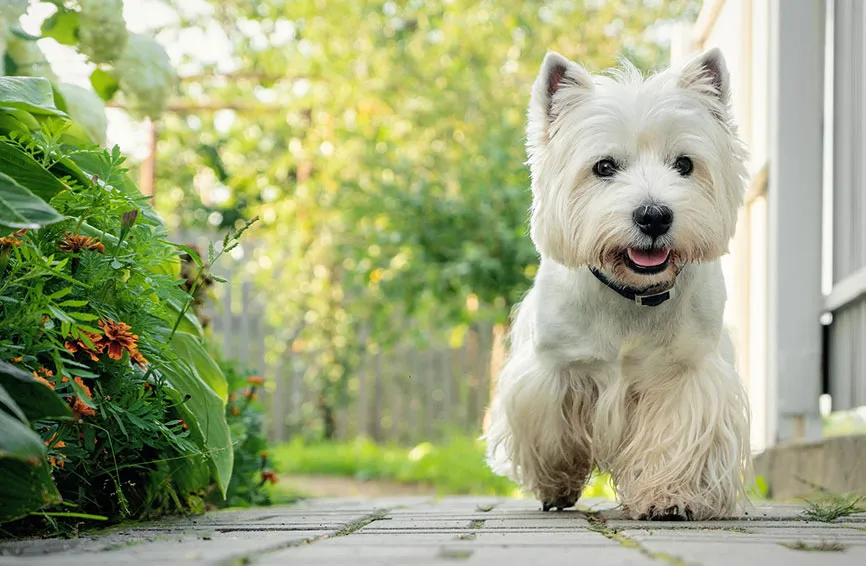
Introduction
Overview of White Highland Terrier Puppy
The White Highland Terrier, affectionately known as the Westie, is a delightful breed with an engaging personality and a captivating snowy coat. These small, well-balanced dogs hail from the rugged landscapes of Scotland, where they were originally bred to hunt vermin. With their distinct double coat, erect ears, and lively expression, Westies are charming companions. Their compact size and playful nature make them a fitting choice for families living in various environments—from cozy apartments to sprawling homes. Westie puppies are simply irresistible, boasting boundless energy, curiosity, and a strong desire to bond with their families.
Why Choose a White Highland Terrier Puppy
Choosing a West Highland Terrier as your new furry friend can yield numerous benefits. Here’s why they make an excellent choice:
- Loyal Companionship: Westies are known for their loyalty, always eager to please and spend quality time with their family.
- Adaptable Nature: Their size makes them suitable for different living situations, whether it’s in the city or the countryside.
- Playful Spirit: With their energetic disposition, Westies thrive on play and adventure, ensuring that life with them is always lively.
- Intelligent and Trainable: Their quick learning abilities make training sessions enjoyable and rewarding.
Bringing a White Highland Terrier into your home can undoubtedly enrich your life with joy and companionship.

Understanding the Breed
History of White Highland Terrier
The West Highland White Terrier, or Westie, boasts a rich history that connects deeply with the rugged terrains of Scotland. Bred as dedicated earthdogs, Westies were originally tasked with hunting vermin, showcasing their agility and small size. Their lineage traces back to prominent historical figures like King James I, who recognized their prowess. In the 18th century, Colonel Malcolm of Poltalloch introduced selective breeding practices that led to the establishment of the iconic white coat, primarily to avoid mistaken identities during hunts. Over the decades, they transitioned from being known as the Roseneath Terrier and the Poltalloch Terrier to gaining widespread acclaim and recognition as “Westies.”
Characteristics and Temperament
Westies are compact yet robust, with a distinctive snow-white double coat that adds to their charm. Their lively expressions encompass wide-set, sparkling eyes and erect ears that reflect curiosity.
Key characteristics include:
- Playful Nature: Known for their energetic disposition, Westies adore playtime, making them fantastic companions for families.
- Intelligence: Their keen minds make them quick learners, readily picking up tricks and commands.
- Affectionate and Loyal: Westies thrive on human interaction, forming strong bonds with their families and often acting as devoted watchdogs.
Whether they’re engaging in activities or simply lounging beside you, Westies are sure to bring joy and laughter into any home.


Finding a Reputable Breeder
Researching Breeders
When searching for a reputable West Highland White Terrier breeder, thorough research is essential. Start by checking local breed clubs and their referral pages, as they often have listings of responsible breeders. Attending dog shows can also be a great way to meet breeders and gain first-hand insights into their practices.
A personal anecdote from a Westie owner emphasizes this point: “I found my Westie at a local dog show. Talking to the breeder and seeing the dogs in action helped me gauge their commitment to the breed.” Look for:
- Club Affiliations: Breeders involved with organizations like the West Highland White Terrier Club of America often adhere to higher breeding standards.
- Health Screenings: Responsible breeders participate in health screenings for common hereditary issues.
Questions to Ask a Breeder
Engaging with potential breeders is crucial. When you find one, don’t hesitate to ask questions. Here are a few key inquiries to consider:
- Health History: What screenings do they conduct for hereditary problems?
- Raising Environment: Can you see where the puppies are raised? Are they socialized?
- Support Policies: Do they offer a return policy if circumstances change for you?
A thoughtful breeder will appreciate your inquiries and openly share details about their breeding practices. Building a relationship with your breeder can ensure that your Westie has a healthy start in life.



Selecting the Perfect Puppy
Puppy Evaluation Checklist
When it comes to selecting your West Highland White Terrier puppy, having a structured checklist can streamline the process. Consider the following aspects to ensure you find a healthy and well-adjusted companion:
- Physical Appearance: Look for a sturdy build, straight legs, and a clean, thick coat.
- Activity Level: A healthy Westie should be active and playful, showing curiosity about its surroundings.
- Cleanliness: Ensure that the puppy’s eyes, ears, and nose are clear of dirt or irritations.
- Temperament: A good puppy should exhibit confidence. Engage with the puppy to see its responsiveness and energy levels.
- Health Indicators: Check for pink gums, a healthy belly (not pot-bellied), and overall vitality.
Remember, when evaluating potential puppies, take your time and don’t rush into a decision.
Red Flags to Watch Out For
As you navigate the puppy selection process, keep an eye out for warning signs:
- Neglect: Look for signs of poor hygiene, such as dirty living conditions or unhealthy pets.
- Shy or Fearful Behavior: Puppies that appear overly timid may not have had proper socialization.
- Early Separation: Avoid breeders offering puppies younger than eight weeks, as this can hinder their development.
Taking a careful approach not only helps you find the right Westie for your family but also supports responsible breeding practices in the long run.



Bringing Your Puppy Home
Preparing Your Home
Bringing a new West Highland White Terrier puppy into your home is an exciting milestone, but it requires thoughtful preparation. Start by creating a safe and comfortable environment for your furry friend. Here are some essential steps:
- Puppy-Proof Your Home: Remove potential hazards such as toxic plants, electrical cords, and small items they could swallow.
- Gather Supplies: Buy a crate, food and water bowls, toys, and quality puppy food. Don’t forget treats for training sessions!
- Set Up a Potty Area: Designate a spot for potty training. Consider using puppy pads or a designated outdoor area.
- Secure Spaces: Use baby gates to limit their access to certain areas. This helps them adjust without feeling overwhelmed by the entire house.
A personal touch can smooth the transition. For instance, bringing home a towel with the puppy’s mother’s scent can provide comfort in their new surroundings.
Initial Care and Training Tips
Initially, your focus should be on establishing routines. Here are a few tips to help:
- Routine Schedule: Stick to consistent feeding and potty times. This aids in establishing their internal clock.
- Socialization: Introduce your Westie to various environments, sounds, and people to build confidence. Positive experiences will help them adapt smoothly.
- Training Basics: Begin with simple commands like “sit” or “stay.” Use positive reinforcement methods—treats and praises—to encourage learning.
A warm and structured environment will lay the foundation for a happy and well-adjusted Westie!


Health and Care Tips
Common Health Issues in White Highland Terriers
Westies are generally hardy dogs, but like all breeds, they can be prone to specific health concerns. Awareness and proactive care can make a significant difference:
- Bladder Cancer: This breed is particularly susceptible to transitional cell carcinoma, which can lead to urinary difficulties. Regular veterinary check-ups are essential for early detection.
- Dental Disease: As Westies age, they often face dental issues due to plaque buildup. Routine dental care, including professional cleaning, is vital to maintain their oral health.
- Dry Eye: Known medically as keratoconjunctivitis sicca, this condition prevents adequate lubrication of the eyes, leading to discomfort. Symptoms include redness and squinting.
- Patellar Luxation: This condition occurs when the kneecap slips out of its groove, causing pain and mobility issues.
Understanding these common issues can prepare you for proactive health management.
Grooming and Exercise Needs
Proper grooming and exercise are crucial for your Westie’s well-being. Their double coat requires:
- Regular Grooming: Weekly brushing helps prevent matting and maintains their stunning white coat. Professional grooming every four to six weeks keeps them looking sharp.
- Daily Exercise: Aim for at least 30 minutes of exercise daily. Activities like walks, fetch, or agility courses can keep them engaged. A bored Westie can become destructive, so regular playtime is essential.
By staying attentive to health and grooming needs, you’ll ensure your Westie remains a happy and healthy member of the family!



Growing Strong Bonds
Building a Strong Relationship
Establishing a strong bond with your West Highland White Terrier is essential for their emotional well-being and your enjoyment as a pet owner. The bond you create will set the foundation for a trusting and affectionate relationship. One effective approach is to spend quality time together engaging in activities that both you and your Westie enjoy.
- Interactive Play: Engage in games like fetch or hide-and-seek to keep them mentally stimulated and physically active.
- Routine Exercise: Regular walks not only boost their health but provide great opportunities for bonding.
- Positive Reinforcement: Show affection and praise when they display good behavior, reinforcing your connection.
Remember, every moment spent together helps strengthen your friendship!
Socialization and Training Advice
To cultivate a well-rounded Westie, early socialization is crucial. Introduce your puppy to a variety of environments, people, and other pets during their formative months.
- Playdates: Arrange meetings with friendly dogs to help them learn proper canine etiquette.
- Training Classes: Enroll in puppy training classes, which provide social experiences and basic obedience skills.
- Positive Training Techniques: Use fun, rewards-based training methods to hold their interest and coax superb behavior.
With dedication and love, your Westie will thrive both socially and in training, contributing to a harmonious household!


Conclusion
Final Tips for Caring for Your White Highland Terrier Puppy
As you embark on this exciting journey with your West Highland White Terrier, it’s important to keep a few key tips in mind to ensure your pup thrives. First and foremost, consistency is crucial. Establish a daily routine for feeding, potty breaks, and exercise. This structure helps your Westie feel secure and understand what to expect.
- Healthy Diet: Invest in high-quality food tailored for puppies to support their growth and health.
- Regular Veterinary Visits: Stay proactive about health screenings to catch any potential issues early.
- Grooming Essentials: Commit to a grooming schedule; regular brushing keeps their coat looking pristine.
Your Journey with Your New Companion
Bringing a Westie into your home is a rewarding commitment filled with joy and laughter. Remember to embrace the energetic and spirited nature of your new companion. Regular playtime, socialization, and training not only build a solid bond but also shape their temperament.
A personal touch goes a long way—spend quality moments cuddling or going on adventures together. This growing relationship will undoubtedly enrich your life, making each day with your Westie an adventure worth cherishing. Enjoy the journey as you both discover the joys of companionship!

Leave a Reply